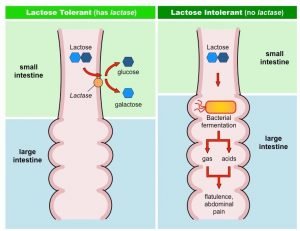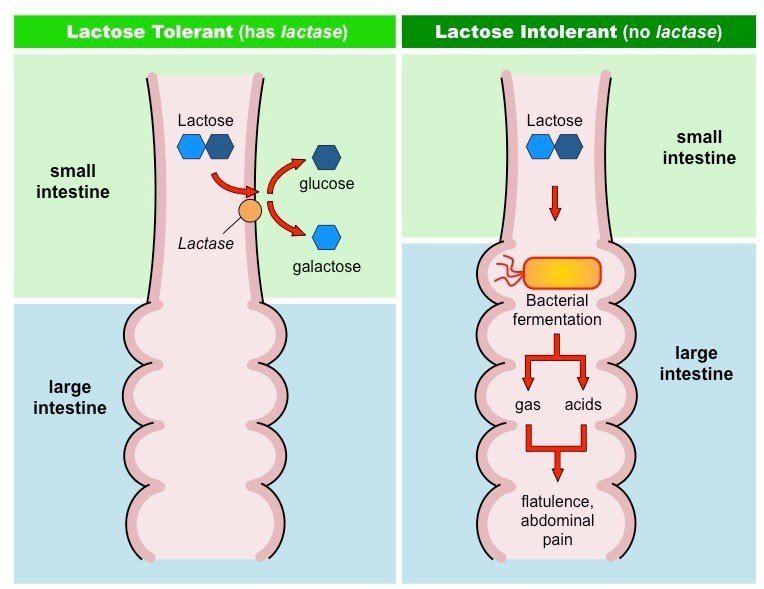Lactose Intolerance

Introduction:
Lactose intolerance is the disease of the digestive tract that develops in an individual due to the deficiency of lactase enzyme in the small intestine and the affected individual is unable to digest the lactose sugar present in the milk or milk related products. As a result, the person suffering from the lactose intolerance has diarrhea, bloating or gas after eating or drinking dairy products. This is the condition of lactose mal-absorption that is usually harmless but may have some uncomfortable digestive system problems. is very common and is thought to affect about 75% people around the world. In this article, the types, causes, symptoms and some other aspects about will be discusses so that you may have the know-how of this disorder.
Types of lactose intolerance:
There are three types of lactose intolerance that usually occur in our surroundings:
Primary lactose intolerance:
This is the most common type of lactose intolerance and is associated with the decrease in the lactase level with the growing age. The infants are born with the power of producing plenty of lactase to get their all nutrition from the milk. In children, there is still enough production of lactase but this production decreases sharply in adulthood that is known as the primary lactose intolerance.
Secondary lactose intolerance:
This is another type of in which the lactase production decreases due to any illness in the abdominal region that involves the intestinal tract. The illness may be due to any injury, surgery or any other disease that is associated with lactose intolerance such as celiac disease, bacterial overgrowth and crown’s disease. Treatment of the underlying associated disorders may restore lactase levels and improve signs and symptoms, though it can take time.
Congenital or developmental lactose intolerance:
It’s rare but still possible for infants to be born with the disorder of complete lactose intolerance that is characterized by the complete lack of lactase activity. This disorder is passed from generation to generation in the pattern of autosomal recessive that both the parents pass their affected gene to their child to become lactose intolerant. Premature infants may also have intolerance because of an insufficient lactase level.
Symptoms of lactose intolerance:
The most common symptoms of lactose intolerance include;
Diarrhea
Gas
Abdominal cramps
Bloating
Irritate bowl syndrome
Inflammatory bowel disease
Nausea
Vomiting
Urgency to go to toilet
Abdominal pain
constipation
Diarrhea occurs due to undigested lactose in your small intestine, which causes water to move into your digestive tract.
Once, the lactose has been reached the colon, lactose is consumed or fermented by the bacteria in the colon. These bacteria produce short-chain fatty acid and gas. This causes the bloating, flatulence and pain.
Causes:
intolerance occur when your small intestine doesn’t produce enough amount of lactase enzyme to digest the milk sugar that is the main sugar present in all dairy products and dairy.
Normally, lactase turns the milk sugar that is lactase into its constituent components that are;
Glucose
Galactose
Which are absorber into the blood stream through intestinal lining.
If a person is lactase deficient, the lactose in food move into the colon undigested and unprocessed. When the in unabsorbed and unprocessed form reaches the colon, normal bacteria interact with that lactose and cause the symptoms and signs of intolerance.
Awareness to the foods rich in lactose:
The following foods that are rich in lactose sugar, should be avoided by a lactose intolerant person:
Cow’s milk (all types)
Goat’s milk
Cheese (including hard and soft cheeses)
Ice cream
Yogurt
Butter
Milk casein
Malted-milk
Buttermilk
Dry milk solids
Whey protein
Sour cream
The foods that contain lactalbumin, lactic acid, lactate or casein should not be omitted from diet as these compounds are not lactose.
Substitute-diets for the lactose intolerant persons:
As the lactose intolerant persons cannot digest the dairy products or milk so they are at risk of losing many useful nutrients such as calcium. But they can take calcium or other nutrients by considering the substitute diets in their meal plan:
Soy-milk: its high in protein, potassium and anti-oxidants.
Rice beverages
Lactose-free milk: Its high in calcium, protein, potassium, zinc, magnesium and contains many other important vitamins e.g vitamin A, B and K.
Almond milk
Coconut milk
Conclusion:
So, lactose intolerance is not a harmful disease but can have negative aspects on your life quality by irritating you GIT. It can be controller easily to cope over its symptoms.

























+ There are no comments
Add yours